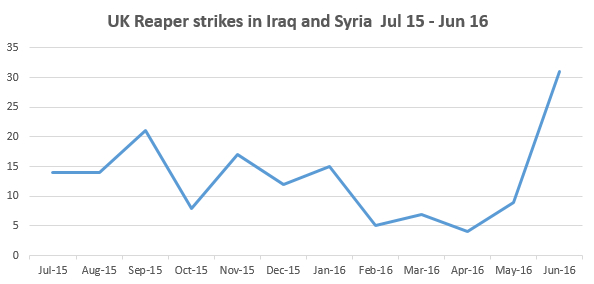British air strikes in Iraq and Syria increase by 85%
By Chris Cole – Analysis of data released by the Ministry of Defence (MoD) shows that British air strikes in Iraq and Syria in the first half of the year increased by an enormous 85% over the previous six months.
FoI data as well as updates published on the MoD’s website show that 249 strikes were launched from British aircraft and drones between July and December 2015, while 464 strikes were launched in the first six months of 2016.
As of the 30 June, the UK has carried out a total of 944 air strikes in Iraq and Syria since September 2014 and it’s likely that the UK will reach the significant milestone of 1,000 air strikes this month. More than 13,500 strikes have been launched by the Coalitionas a whole, the vast majority by the USAF. However it should be remember that the term ‘air strike’ can cover a variety of attacks, ranging from a single weapon launched at one target, to multiple weapons launched at different targets within the same area. In July 2015 the UK changed the way it traditionally calculated air strikes adopting instead the US methodology. This resulted in around a 30% drop in the recorded number of strikes. See this letter from the MoD explaining the different methodologies.
Strikes Surge, bigger bombs
The surge in strikes over the past six months can partially be attributed to the increase in the number of British aircraft taking part in bombing raids. An additional 2 Tornado and 6 Typhoon aircraft weredespatched to the region following the House of Commons vote to undertake strikes in Syria in December 2015. In addition, the Iraqi and Kurdish advance on Ramadi at the turn of the year and more recently the advance on Fallujah has also meant an upswing in the number of strikes.
As well as an increase in the number of strikes, the UK has also begun to fire much large weapons in the last three months. On six occasions since mid-April, the UK launched multiple loads of the 1,000 lb Enhanced Paveway II and 2,000 lb Paveway III bombs, while on the 26 June, British Tornados launched 4 Stormshadow Cruise Missiles. All these larger strikes were pre-planned in contrast to the vast majority of strikes which are dynamically targeted – that is launched ‘on the fly’.
Drone use
Within the overall figures, it can be seen that the number of strikes carried out by British drones dipped between Jan and April 2016 (see graph below). It is not clear why this happened but possible explanations include that the drones were being used primarily for surveillance; that they had been taken out of service to be re-fitted with new equipment (a news report showing footage of British Reapers was blurred in May 2016 due to the addition of classified equipment); or even that some of the drones had been deployed on operations elsewhere.
Since April however there has been a marked increase in the number of strikes carried out by British drones. According to our analysis, with a total of 31 separate strikes, June 2016 has seen the highest ever number of strikes carried out by British drones in one month since the RAF began using drones in October 2007.

British air strikes in Syria
While MPs voted in December 2015 to undertake strikes in Syria as well as Iraq, the number of British strikes that have taken place in Syria continues to be small in comparison to strikes in Iraq. Despite Michael Fallon’s argument that it was “morally indefensible” for the UK not to bomb in Syria and David Cameron’s insistence that the UK had to “crush the head of the snake”, just 51 strikes – 11% of the strikes that have taken place since the December vote – have occurred in Syria with the majority of those occurring in December 15/January 16.
British air strikes in Syria (Dec 15 – Jun 2016)

Towards Chilcot #2?
SafeSubcribe/Instant Unsubscribe - One Email, Every Sunday Morning - So You Miss Nothing - That's It
This week the Chilcot Report will finally be published and a little more light may be shed on the invasion of Iraq in 2003. The rise of ISIS and the roots of the current conflict in Iraq and beyond can be traced back to the disastrous decision of Bush and Blair to undertake what they euphemistically called ‘regime change’.
Blair and Bush believed that military force could remove Saddam’s regime, create peace and security for people in Iraq and the wider region, and open up huge commercial opportunities for Western corporations. They were spectacularly wrong. Though Bush and Blair have long departed centre stage, the same faith in the effectiveness of military force to ‘take out the bad guys’ and lay the basis for lasting peace and security through flying daily bombing missions over Fallujah and Mosul is alive and well.
Meanwhile, casualty recorders continue to count the growing number of civilian dead from the air strikes. Airwars latest estimate is that a minimum of 1,358 civilians have died in the coalition bombing. The US admit to only 42 civilians having “likely” died, in their thousands of strikes, while the UK insist there is no evidence that any civilians have been killed or even injured in any of its strikes.
In many ways the hubris displayed by Bush and Blair, as well as its awful legacy, lives on.
Chris Cole is a former Director of the Fellowship of Reconciliation and co-ordinator of Campaign Against Arms Trade (CAAT). For the past four years Chris has been researching and campaigning on the issue of armed drones. He is co-author of Convenient Killing: Armed Drones and the Playstation Mentality (2010), secretary of the Drones Campaign Network and maintains the internationally respected Drone Wars UK website www.dronewars.net




